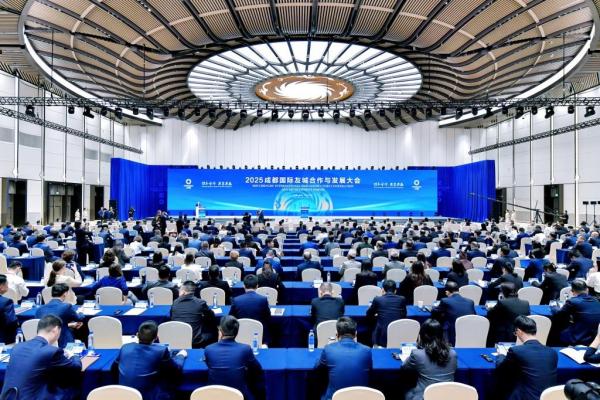- Home
- MediaOutReach
- VT Markets Exclusive Analysis: Global Capital May Shift Amid Tariff Shock and AI Disruption
VT Markets Exclusive Analysis: Global Capital May Shift Amid Tariff Shock and AI Disruption
Kamis, 10 April 2025 | 08:48

HONG KONG SAR -
Media OutReach Newswire
- 9 April 2025 - 2025 has marked a turning point for global stock
markets, as U.S. stocks, once the uncontested giants, now face a
dramatic decline, while European markets surge ahead. The VT Markets
Research Desk points to two powerful forces reshaping the landscape:
U.S. tariff policies and China's booming AI sector. Under the pressure
of both internal and external challenges, U.S. stocks have lost their
once-leading position.
Meanwhile, markets in Germany, France, and the UK have gained momentum thanks to a manufacturing revival. Hong Kong's Hang Seng Index has soared, boosted by the launch of DeepSeek and China's thriving tech sector. However, the broader Asian market struggles, with Australia, a key trade partner of China, also feeling the weight of the downturn alongside U.S. stocks.
Impact of Trump's Tariff Policy
Trump's tariff strategy has resurfaced, revealing deep structural contradictions in U.S. trade. According to data from the U.S. Department of Commerce, the U.S. current account deficit grew by $228.2 billion in 2024, reaching $1.13 trillion. This increase is primarily attributed to a further expansion of the goods deficit. In this context, new tariffs – including a 20% tariff on China and 25% punitive tariffs on steel and aluminum – appear to serve as a strategic deterrent.
Despite Trump's claims that the tariffs are aimed at reducing the trade deficit, the reality is more complex. The VT Markets Research Desk reports that a significant portion of the U.S. trade deficit is generated by American companies operating overseas. These firms set up production in Asia and ship goods back to the U.S., creating an apparent trade deficit. While the new tariffs might improve the deficit somewhat, the main goal is to pressure other nations into negotiations and encourage the return of manufacturing to the U.S.
This policy shift has not only affected international trade dynamics but has also triggered the rotation of capital away from U.S. stocks.
Tech Stock Decline and the Rise of Defensive Sectors
Investor concerns regarding the impact of new tariffs on U.S. corporate supply chains, coupled with a cautious stance from the Federal Reserve, have led to capital fleeing from tech giants, even as Q1 earnings season showed that 75% of U.S. companies exceeded profit expectations. Market sentiment is now predicting a slowdown in profit growth for 2025.
In the past three months, U.S. tech stocks have suffered significant sell-offs. Nvidia, for example, has dropped 21.6% year-to-date, losing its position as the most valuable company in the country. Other tech giants such as Apple, Microsoft, Google, and Amazon have seen declines ranging from 8% to 18%. In response, funds have shifted towards defensive sectors like healthcare, non-cyclical consumer goods, and utilities. More conservative investors have opted to increase their cash holdings.
While the stock market correction may seem like a warning sign, it could also alleviate concerns of market bubble risks by reducing excessive capital concentration in the tech sector.
Second Quarter Outlook and Investment Strategy
Looking ahead to the second quarter, the real storm is approaching. On April 2, several previously delayed tariff policies will be enacted. These include reciprocal tariffs, a 25% tariff on goods from Canada and Mexico (which were previously postponed due to USMCA), and secondary tariffs aimed at isolating Venezuela by taxing goods from countries purchasing oil the country. Additionally, a 25% tariff will be imposed on automobiles. However, there is still no definitive information regarding the semiconductor and pharmaceutical sectors.
The VT Markets report notes that these policy changes could trigger retaliatory tariffs globally, leading to increased economic risks and prolonged weakness in U.S. stock indices.
Given the highly uncertain market environment, the VT Markets Research Desk advises investors to focus on two key signals: First, whether positive news could prompt U.S. stocks to bottom out. With the current climate being unclear, investors should avoid trying to "catch the bottom." Second, until the fog of uncertainty dissipates, traders are recommended to adopt a more defensive stance, reducing risk exposure by increasing the proportion of risk-free assets in their portfolios.
VT Markets Research Disclaimer: This analysis is based on market data and information available at the time of writing, dated March 31, 2025. Given the real-time volatility of the financial markets, the views expressed in this document may be adjusted as market conditions change. Readers are advised to consider the latest developments and make informed judgments when referencing this content.
https://www.linkedin.com/company/89310903/admin/feed/posts/
https://www.facebook.com/VTMarketsCN
https://www.instagram.com/vtmarkets/
Meanwhile, markets in Germany, France, and the UK have gained momentum thanks to a manufacturing revival. Hong Kong's Hang Seng Index has soared, boosted by the launch of DeepSeek and China's thriving tech sector. However, the broader Asian market struggles, with Australia, a key trade partner of China, also feeling the weight of the downturn alongside U.S. stocks.
Impact of Trump's Tariff Policy
Trump's tariff strategy has resurfaced, revealing deep structural contradictions in U.S. trade. According to data from the U.S. Department of Commerce, the U.S. current account deficit grew by $228.2 billion in 2024, reaching $1.13 trillion. This increase is primarily attributed to a further expansion of the goods deficit. In this context, new tariffs – including a 20% tariff on China and 25% punitive tariffs on steel and aluminum – appear to serve as a strategic deterrent.
Despite Trump's claims that the tariffs are aimed at reducing the trade deficit, the reality is more complex. The VT Markets Research Desk reports that a significant portion of the U.S. trade deficit is generated by American companies operating overseas. These firms set up production in Asia and ship goods back to the U.S., creating an apparent trade deficit. While the new tariffs might improve the deficit somewhat, the main goal is to pressure other nations into negotiations and encourage the return of manufacturing to the U.S.
This policy shift has not only affected international trade dynamics but has also triggered the rotation of capital away from U.S. stocks.
Tech Stock Decline and the Rise of Defensive Sectors
Investor concerns regarding the impact of new tariffs on U.S. corporate supply chains, coupled with a cautious stance from the Federal Reserve, have led to capital fleeing from tech giants, even as Q1 earnings season showed that 75% of U.S. companies exceeded profit expectations. Market sentiment is now predicting a slowdown in profit growth for 2025.
In the past three months, U.S. tech stocks have suffered significant sell-offs. Nvidia, for example, has dropped 21.6% year-to-date, losing its position as the most valuable company in the country. Other tech giants such as Apple, Microsoft, Google, and Amazon have seen declines ranging from 8% to 18%. In response, funds have shifted towards defensive sectors like healthcare, non-cyclical consumer goods, and utilities. More conservative investors have opted to increase their cash holdings.
While the stock market correction may seem like a warning sign, it could also alleviate concerns of market bubble risks by reducing excessive capital concentration in the tech sector.
Second Quarter Outlook and Investment Strategy
Looking ahead to the second quarter, the real storm is approaching. On April 2, several previously delayed tariff policies will be enacted. These include reciprocal tariffs, a 25% tariff on goods from Canada and Mexico (which were previously postponed due to USMCA), and secondary tariffs aimed at isolating Venezuela by taxing goods from countries purchasing oil the country. Additionally, a 25% tariff will be imposed on automobiles. However, there is still no definitive information regarding the semiconductor and pharmaceutical sectors.
The VT Markets report notes that these policy changes could trigger retaliatory tariffs globally, leading to increased economic risks and prolonged weakness in U.S. stock indices.
Given the highly uncertain market environment, the VT Markets Research Desk advises investors to focus on two key signals: First, whether positive news could prompt U.S. stocks to bottom out. With the current climate being unclear, investors should avoid trying to "catch the bottom." Second, until the fog of uncertainty dissipates, traders are recommended to adopt a more defensive stance, reducing risk exposure by increasing the proportion of risk-free assets in their portfolios.
VT Markets Research Disclaimer: This analysis is based on market data and information available at the time of writing, dated March 31, 2025. Given the real-time volatility of the financial markets, the views expressed in this document may be adjusted as market conditions change. Readers are advised to consider the latest developments and make informed judgments when referencing this content.
https://www.linkedin.com/company/89310903/admin/feed/posts/
https://www.facebook.com/VTMarketsCN
https://www.instagram.com/vtmarkets/
BERITA LAINNYA

Jumat, 18 April 2025 | 08:34

Jumat, 18 April 2025 | 08:33

Jumat, 18 April 2025 | 08:31

Jumat, 18 April 2025 | 08:30

Jumat, 18 April 2025 | 08:27

Jumat, 18 April 2025 | 08:25

Jumat, 18 April 2025 | 08:23

Kamis, 17 April 2025 | 14:43

Kamis, 17 April 2025 | 14:41





















